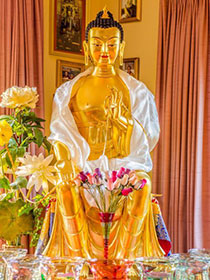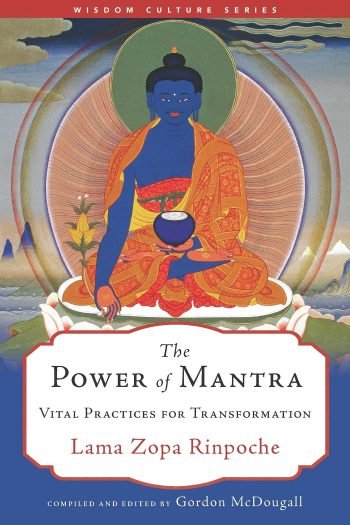- Home
- FPMT Homepage
Foundation for the Preservation of the Mahayana Tradition
The FPMT is an organization devoted to preserving and spreading Mahayana Buddhism worldwide by creating opportunities to listen, reflect, meditate, practice and actualize the unmistaken teachings of the Buddha and based on that experience spreading the Dharma to sentient beings. We provide integrated education through which people’s minds and hearts can be transformed into their highest potential for the benefit of others, inspired by an attitude of universal responsibility and service. We are committed to creating harmonious environments and helping all beings develop their full potential of infinite wisdom and compassion. Our organization is based on the Buddhist tradition of Lama Tsongkhapa of Tibet as taught to us by our founders Lama Thubten Yeshe and Lama Thubten Zopa Rinpoche.
- Willkommen
Die Stiftung zur Erhaltung der Mahayana Tradition (FPMT) ist eine Organisation, die sich weltweit für die Erhaltung und Verbreitung des Mahayana-Buddhismus einsetzt, indem sie Möglichkeiten schafft, den makellosen Lehren des Buddha zuzuhören, über sie zur reflektieren und zu meditieren und auf der Grundlage dieser Erfahrung das Dharma unter den Lebewesen zu verbreiten.
Wir bieten integrierte Schulungswege an, durch denen der Geist und das Herz der Menschen in ihr höchstes Potential verwandelt werden zum Wohl der anderen – inspiriert durch eine Haltung der universellen Verantwortung und dem Wunsch zu dienen. Wir haben uns verpflichtet, harmonische Umgebungen zu schaffen und allen Wesen zu helfen, ihr volles Potenzial unendlicher Weisheit und grenzenlosen Mitgefühls zu verwirklichen.
Unsere Organisation basiert auf der buddhistischen Tradition von Lama Tsongkhapa von Tibet, so wie sie uns von unseren Gründern Lama Thubten Yeshe und Lama Thubten Zopa Rinpoche gelehrt wird.
- Bienvenidos
La Fundación para la preservación de la tradición Mahayana (FPMT) es una organización que se dedica a preservar y difundir el budismo Mahayana en todo el mundo, creando oportunidades para escuchar, reflexionar, meditar, practicar y actualizar las enseñanzas inconfundibles de Buda y en base a esa experiencia difundir el Dharma a los seres.
Proporcionamos una educación integrada a través de la cual las mentes y los corazones de las personas se pueden transformar en su mayor potencial para el beneficio de los demás, inspirados por una actitud de responsabilidad y servicio universales. Estamos comprometidos a crear ambientes armoniosos y ayudar a todos los seres a desarrollar todo su potencial de infinita sabiduría y compasión.
Nuestra organización se basa en la tradición budista de Lama Tsongkhapa del Tíbet como nos lo enseñaron nuestros fundadores Lama Thubten Yeshe y Lama Zopa Rinpoche.
A continuación puede ver una lista de los centros y sus páginas web en su lengua preferida.
- Bienvenue
L’organisation de la FPMT a pour vocation la préservation et la diffusion du bouddhisme du mahayana dans le monde entier. Elle offre l’opportunité d’écouter, de réfléchir, de méditer, de pratiquer et de réaliser les enseignements excellents du Bouddha, pour ensuite transmettre le Dharma à tous les êtres. Nous proposons une formation intégrée grâce à laquelle le cœur et l’esprit de chacun peuvent accomplir leur potentiel le plus élevé pour le bien d’autrui, inspirés par le sens du service et une responsabilité universelle. Nous nous engageons à créer un environnement harmonieux et à aider tous les êtres à épanouir leur potentiel illimité de compassion et de sagesse. Notre organisation s’appuie sur la tradition guéloukpa de Lama Tsongkhapa du Tibet, telle qu’elle a été enseignée par nos fondateurs Lama Thoubtèn Yéshé et Lama Zopa Rinpoché.
Visitez le site de notre Editions Mahayana pour les traductions, conseils et nouvelles du Bureau international en français.
Voici une liste de centres et de leurs sites dans votre langue préférée
- Benvenuto
L’FPMT è un organizzazione il cui scopo è preservare e diffondere il Buddhismo Mahayana nel mondo, creando occasioni di ascolto, riflessione, meditazione e pratica dei perfetti insegnamenti del Buddha, al fine di attualizzare e diffondere il Dharma fra tutti gli esseri senzienti.
Offriamo un’educazione integrata, che può trasformare la mente e i cuori delle persone nel loro massimo potenziale, per il beneficio di tutti gli esseri, ispirati da un’attitudine di responsabilità universale e di servizio.
Il nostro obiettivo è quello di creare contesti armoniosi e aiutare tutti gli esseri a sviluppare in modo completo le proprie potenzialità di infinita saggezza e compassione.
La nostra organizzazione si basa sulla tradizione buddhista di Lama Tsongkhapa del Tibet, così come ci è stata insegnata dai nostri fondatori Lama Thubten Yeshe e Lama Zopa Rinpoche.
Di seguito potete trovare un elenco dei centri e dei loro siti nella lingua da voi prescelta.
- 欢迎 / 歡迎
简体中文
“护持大乘法脉基金会”( 英文简称:FPMT。全名:Foundation for the Preservation of the Mahayana Tradition) 是一个致力于护持和弘扬大乘佛法的国际佛教组织。我们提供听闻,思维,禅修,修行和实证佛陀无误教法的机会,以便让一切众生都能够享受佛法的指引和滋润。
我们全力创造和谐融洽的环境, 为人们提供解行并重的完整佛法教育,以便启发内在的环宇悲心及责任心,并开发内心所蕴藏的巨大潜能 — 无限的智慧与悲心 — 以便利益和服务一切有情。
FPMT的创办人是图腾耶喜喇嘛和喇嘛梭巴仁波切。我们所修习的是由两位上师所教导的,西藏喀巴大师的佛法传承。
繁體中文
護持大乘法脈基金會”( 英文簡稱:FPMT。全名:Found
ation for the Preservation of the Mahayana Tradition ) 是一個致力於護持和弘揚大乘佛法的國際佛教組織。我們提供聽聞, 思維,禪修,修行和實證佛陀無誤教法的機會,以便讓一切眾生都能 夠享受佛法的指引和滋潤。 我們全力創造和諧融洽的環境,
為人們提供解行並重的完整佛法教育,以便啟發內在的環宇悲心及責 任心,並開發內心所蘊藏的巨大潛能 — 無限的智慧與悲心 – – 以便利益和服務一切有情。 FPMT的創辦人是圖騰耶喜喇嘛和喇嘛梭巴仁波切。
我們所修習的是由兩位上師所教導的,西藏喀巴大師的佛法傳承。 察看道场信息:
- FPMT Homepage
- News/Media
-
- Study & Practice
-
-
- About FPMT Education Services
- Latest News
- Programs
- New to Buddhism?
- Buddhist Mind Science: Activating Your Potential
- Heart Advice for Death and Dying
- Discovering Buddhism
- Living in the Path
- Exploring Buddhism
- FPMT Basic Program
- FPMT Masters Program
- FPMT In-Depth Meditation Training
- Maitripa College
- Lotsawa Rinchen Zangpo Translator Program
- Universal Education for Compassion & Wisdom
- Online Learning Center
-
- Prayers & Practice Materials
- Overview of Prayers & Practices
- Full Catalogue of Prayers & Practice Materials
- Explore Popular Topics
- Benefiting Animals
- Chenrezig Resources
- Death & Dying Resources
- Lama Chopa (Guru Puja)
- Lama Zopa Rinpoche: Compendium of Precious Instructions
- Lama Zopa Rinpoche: Life Practice Advice
- Lama Zopa Rinpoche Practice Series
- Lamrim Resources
- Mantras
- Prayer Book Updates
- Purification Practices
- Sutras
- Thought Transformation (Lojong)
- Audio Materials
- Dharma Dates - Tibetan Calendar
- Translation Services
- Publishing Services
- Ways to Offer Support
- Prayers & Practice Materials
-
- Teachings and Advice
- Find Teachings and Advice
- Lama Zopa Rinpoche Advice Page
- Lama Zopa Rinpoche: Compendium of Precious Instructions
- Lama Zopa Rinpoche Video Teachings
- ༧སྐྱབས་རྗེ་བཟོད་པ་རིན་པོ་ཆེ་མཆོག་ནས་སྩལ་བའི་བཀའ་སློབ་བརྙན་འཕྲིན།
- Podcasts
- Lama Yeshe Wisdom Archive
- Buddhism FAQ
- Dharma for Young People
- Resources on Holy Objects
- Teachings and Advice
-
-
*If a menu item has a submenu clicking once will expand the menu clicking twice will open the page.
-
-
- Centers
-
- Teachers
-
- Projects
-
-
-
-
*If a menu item has a submenu clicking once will expand the menu clicking twice will open the page.
-
-
- FPMT
-
-
-
-
-
To meet the challenge of our times, human beings will have to develop a greater sense of universal responsibility. Each of us must learn to work not just for his or her own self, family or nation, but for all.
His Holiness the Dalai Lama
-
-
-
- Shop
-
-
-
The Foundation Store is FPMT’s online shop and features a vast selection of Buddhist study and practice materials written or recommended by our lineage gurus. These items include homestudy programs, prayers and practices in PDF or eBook format, materials for children, and other resources to support practitioners.
Items displayed in the shop are made available for Dharma practice and educational purposes, and never for the purpose of profiting from their sale. Please read FPMT Foundation Store Policy Regarding Dharma Items for more information.
-
-
Lama Zopa Rinpoche News and Advice
2
There Are No Limits to the Benefits of Bodhicitta
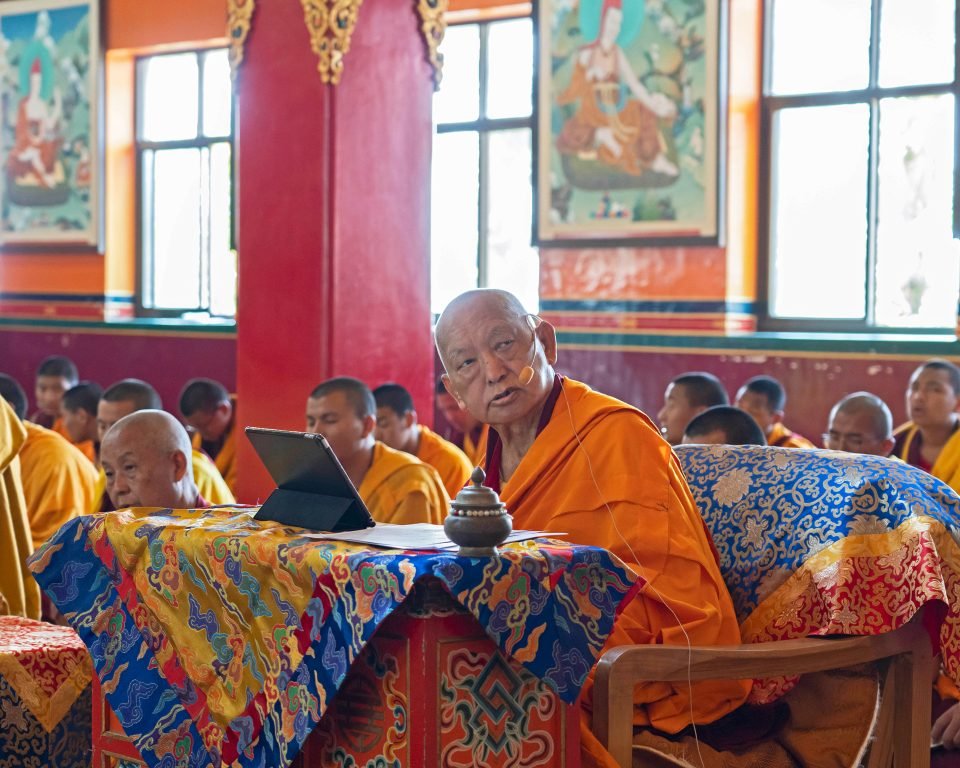
Lama Zopa Rinpoche in the Kopan Monastery gompa, Nepal, May 2022. Photo by Ven. Lobsang Sherab.
Lama Zopa Rinpoche begins this video, which was recorded in April 2018 at the Great Stupa of Universal Compassion in Bendigo, Australia, by reminding us of the benefits of making even a tiny offering to a holy object. But, Rinpoche explains, those benefits are far exceeded by the mere thought of benefiting sentient beings.
Rinpoche quotes from Lama Atisha’s Lamp of the Path to Enlightenment:
Gang gi thäl mo jar gyi te
Jang chhub tu ni sem tü na
Chhö pa di ni kyä par phag
De la tha ni ma chhi so
This is surpassed by
The offering of putting the palms together
And generating bodhicitta,
For such is limitless.
Rinpoche then mentions a quotation on bodhicitta from Shantideva’s Bodhicharyavatara:
Phän par sam pa tsam gyi kyang
Sang gyä chö lä khyä phag na
Even the mere thought to benefit someone
Surpasses making offerings to the buddhas.
Rinpoche explains how it is shown that the mere thought of benefiting a single sentient being, surpasses skies of offerings done to all the buddhas.
When our motivation is to achieve enlightenment for the numberless sentient beings, to free them from the oceans of samsaric sufferings and bring them to peerless happiness, the total cessation of obscurations and completion of realizations, this is truly incredible, because it is for all sentient beings. So this creates an unbelievable amount of merit. And it is so important to remember the benefits of bodhicitta.
Watch the video “There Are No Limits to the Benefits of Bodhicitta”:
The above video is extracted from a teaching given on April 13, 2018, at the Great Stupa of Universal Compassion in Bendigo, Australia. You can find more blogs with short video clips from Rinpoche’s teaching as well as the complete collection of these “Essential Extracts” videos on FPMT.org.
Lama Zopa Rinpoche is the spiritual director of the Foundation for the Preservation of Mahayana Tradition (FPMT), a Tibetan Buddhist organization dedicated to the transmission of the Mahayana Buddhist tradition and values worldwide through teaching, meditation and community service.
23

Lama Zopa Rinpoche giving a teaching to students attending the three-month Vajrasattva retreat at Kopan Monastery, Nepal, April 2022. Photo by Ven. Lobsang Sherab.
Lama Zopa Rinpoche gave this teaching to students attending the three-month Vajrasattva retreat at Kopan Monastery in Nepal on April 27, 2022. Here’s a summary of Rinpoche’s teaching. You can find the video of the teaching and a link to the transcript below.
If you want to know the truth of the world, the truth of yourself, and if you want to be free from the oceans of samsaric suffering, then you have to know the root cause of suffering, Lama Zopa Rinpoche explains. The world is full of things that are a waste of time. If you don’t know what is right or wrong, your meditation will not amount to anything, and you can waste so much of this life. You need to meet the correct teachings and that depends on merit. And you have to have faith and make correction prayers and dedications. Otherwise, it’s difficult. You could meet Buddhism but fall into eternalism or nihilism.
Rinpoche offers the retreatants a brief history of how the first month-long Kopan Course began (14:37 in the video). There have been fifty-two courses since this first course in 1971.
Generating bodhicitta when listening to the teachings is unbelievable. Even if we don’t have realizations, listening to the teachings with a bodhicitta motivation and offering them to numberless sentient beings is unbelievable. This means we listen to the teachings and dedicate to every hell being, every hungry ghost, every animal, including every ant and mosquito. So we listen to the teachings for them—not only to free them from samsara and bring them to nirvana, but for their ultimate happiness, the total cessation of obscurations and the completion of realizations.
Rinpoche leads the group in offering coffee and cake, including the Clouds of Offering Mantra (48:08 in the video).
Rinpoche continues the teaching, saying that it is so important to understand what the I is. All problems go away when we understand this, Rinpoche assures us. But when we believe in the hallucinated appearance of the I, so many problems arise. Because we don’t know the cause of happiness, due to ignorance, we destroy the cause as if it was an outside enemy. In fact, we rush to create the cause of suffering—like a fisherman who desires happiness and rushes to catch fish for money or pleasure, and due to that killing gets reborn as a fish and gets killed in future lives. Abandoning nonvirtue is the source of happiness. If we can abandon killing, for example, even a mosquito in our room, this becomes the source of happiness for us, and also so much happiness for the beings we don’t harm. In addition, the best protection from being killed is to stop killing.
Rinpoche explains the four parts of completing the action of killing (1:17:12 in the video), discusses the purification practice utilizing the four powers (1:43:19 in the video), and offers some stories of those who have committed the heavy negative karma of killing and how they purified these mistakes.
We invite you to go deeper into the topics presented here, plus many others, by watching Rinpoche’s video or reading the full transcript of Rinpoche’s teaching.
Watch Lama Zopa Rinpoche’s teaching “Abandoning Nonvirtue Is a Source of Happiness for You”:
Lama Zopa Rinpoche gave four teachings to students attending the 2022 Vajrasattva retreat: an introductory teaching on March 30 and three subsequent teachings on April 26–28. We will release the concluding teaching soon. You can find them on our page “Teachings for 2022 Vajrasattva Retreatants at Kopan Monastery.”
Find links to resources to support your Vajrasattva practice in the Foundation Store.
This summary of Lama Zopa Rinpoche’s teaching is by Carina Rumrill, based on the live transcript by Ven. Joan Nicell and checked by Laura Haughey, with editorial input and additions by Laura Miller. This summary is meant to highlight key topics presented by Rinpoche in the recorded video and is not intended to serve as a full representation of Rinpoche’s teaching, which is best received through watching the video and/or reading the full transcript.
Lama Zopa Rinpoche is the spiritual director of the Foundation for the Preservation of Mahayana Tradition (FPMT), a Tibetan Buddhist organization dedicated to the transmission of the Mahayana Buddhist tradition and values worldwide through teaching, meditation and community service.
- Tagged: advice from lama zopa rinpoche, food offering, kopan course, kopan monastery, offering, purification practice, vajrasattva, video
19
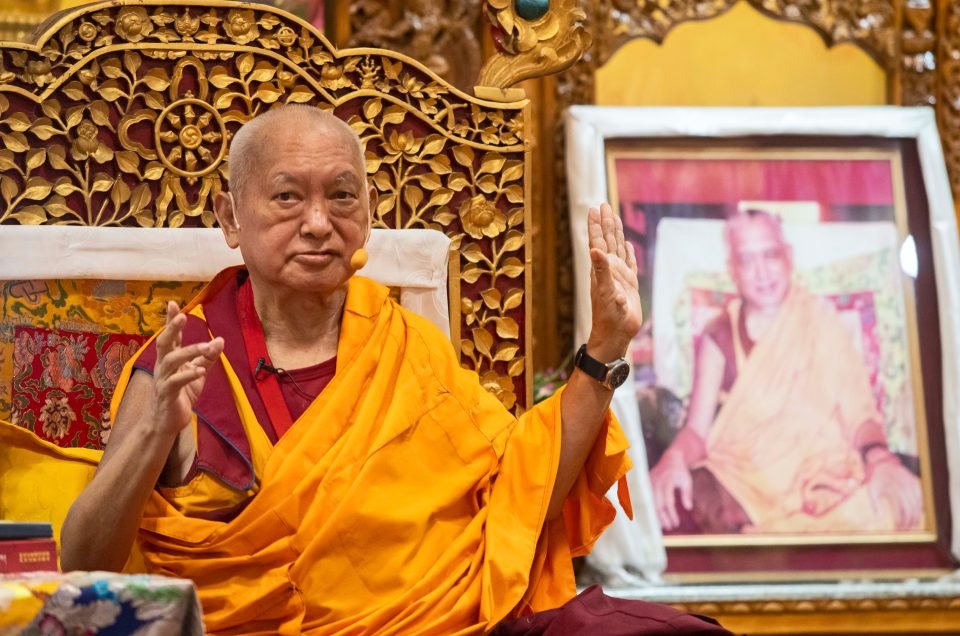
Lama Zopa Rinpoche giving a teaching to students attending the three-month Vajrasattva retreat at Kopan Monastery, Nepal, April 2022. Photo by Ven. Lobsang Sherab.
“Your coming here to do Vajrasattva, wow, that’s really what you need,” Lama Zopa Rinpoche told the students attending the three-month Vajrasattva retreat at Kopan Monastery in Nepal on April 26, 2022. Here’s a summary of Rinpoche’s teaching. You can find the video of the teaching and a link to the transcript below.
The more wealth one accumulates, the more attachment, dissatisfaction, and miserliness can develop, Rinpoche teaches. A beggar who lives every day begging for a little money is content with that. But those who have millions and billions of dollars suffer so much, and so much unhappiness arises.
There are many different levels of truth because there are so many hallucinations in life. By attending a meditation course like the Vajrasattva retreat at Kopan Monastery, one is learning about the hallucinations of life and all the levels of conventional truth. As we learn more through analytical and fixed meditation, the mind becomes happier and happier. Then, by benefiting others with a good heart—even one insect or one person—the mind has the greatest happiness, and life is so worthwhile. Practicing a good heart keeps depression away, and we can die smiling because life has been lived in service to others. If we are always angry, and follow a selfish mind, we create so much unhappiness in life and destroy the immune system, Rinpoche warns.
The Buddha’s teachings are from someone who has omniscience, perfect power, and compassion embracing every sentient being. By deciding to follow the Buddha’s teachings, one makes the most correct decision, Rinpoche says. A hallucinated I, a false I, is the root of samsara, ignorance. If we don’t like problems, we should be working to free ourselves from samsara. Therefore, we need to listen to the correct teachings from a correct guide, and then reflect and meditate, and then realizations come.
Rinpoche offers three ways to meditate on emptiness and provides commentary for each (starting at 1:38:40 in the video):
- Meditate that everything is a hallucination.
- Meditate that everything is merely imputed.
- Meditate that everything is empty.
Rinpoche then quotes Lama Tsongkhapa:
“Ignorance, which is in the nature of exaggeration, exaggerates the discrimination of good or bad. Then attachment and anger arise. Therefore, the way this [wrong concept] apprehends [objects] can also be eliminated by logic.”
Attachment and anger arise after the discrimination of good and bad. First we believe everything is truly existent, then we assign good or bad, and then attachment and anger arise. We can understand how our concepts and thoughts are wrong using this logic. And once we see that they are wrong, then we can eliminate them. In everyday life, practice seeing things as empty. Then, by actualizing emptiness, we can stop the creation of delusion and karma and become free from the suffering of samsara forever. Then, we achieve ultimate happiness, and with bodhicitta, we achieve enlightenment.
We invite you to go deeper into the topics presented here, plus many others, by watching Rinpoche’s video or reading the full transcript of Rinpoche’s teaching.
Watch Lama Zopa Rinpoche’s teaching “By Doing Vajrasattva, You Are Doing Exactly What You Need to Do”:
Lama Zopa Rinpoche gave four teachings to students attending the 2022 Vajrasattva retreat: an introductory teaching on March 30 and three subsequent teachings on April 26–28. You can find them on our page “Teachings for 2022 Vajrasattva Retreatants at Kopan Monastery.”
Find links to resources to support your Vajrasattva practice in the Foundation Store.
This summary of Lama Zopa Rinpoche’s teaching is by Carina Rumrill, based on the live transcript by Ven. Joan Nicell and checked by Laura Haughey, with editorial input and additions by Laura Miller. This summary is meant to highlight key topics presented by Rinpoche in the recorded video and is not intended to serve as a full representation of Rinpoche’s teaching, which is best received through watching the video and/or reading the full transcript.
Lama Zopa Rinpoche is the spiritual director of the Foundation for the Preservation of Mahayana Tradition (FPMT), a Tibetan Buddhist organization dedicated to the transmission of the Mahayana Buddhist tradition and values worldwide through teaching, meditation and community service.
- Tagged: advice from lama zopa rinpoche, vajrasattva, video
18

Lama Zopa Rinpoche with Khandro Kunga Bhuma, Kopan Monastery, Nepal, March 2022. Photo by Ven. Roger Kunsang.
Every year FPMT CEO Ven. Roger Kunsang, on behalf of the FPMT organization, checks with Khandro-la (Khandro Kunga Bhuma) to determine what practices should be done to help create the conditions for FPMT’s Spiritual Director, Lama Zopa Rinpoche, to have a long life and good health for the coming year. In addition to the pujas and practices already advised, Khandro-la’s recent observation is that there are still obstacles to Rinpoche’s health.
Ven. Roger shared, “Khandro-la is therefore strongly advising students to continue to offer practices dedicated for Rinpoche’s good health, and now specifically to recite refuge and bodhicitta prayers. We sincerely request students to start this now or as soon as possible, and to continue over the coming two months. Individual students can offer this practice themselves, and we encourage centers to organize group practice sessions for this.”
We appreciate everyone’s swift engagement with these recommended prayers, dedicating strongly for Lama Zopa Rinpoche’s health and very long life.
Taking Refuge and Generating Bodhicitta
Sang gyä chhö dang tshog kyi chhog nam la
Jang chhub bar du dag ni kyab su chhi
Dag gi jin sog gyi päi tshog nam kyi
Dro la phän chhir sang gyä drub par shog
I take refuge until I am enlightened
In the Buddha, the Dharma, and the Supreme Assembly.
By my merits of generosity and so forth,
May I become a buddha to benefit transmigratory beings.
From FPMT Education Services’ Daily Prayers.
* Lama Zopa Rinpoche advised to replace sö nam (Tib. gsod rnams) in the third line with tshog nam (Tib. tshogs rnams), in accordance with His Holiness the Dalai Lama’s advice, and to translate tshog nam as “merits,” rather than “accumulation” or “collections.” Rinpoche explains that the two types of merits are the merits of virtue and the merits of wisdom, which are often translated as the “accumulation of merit” and the “accumulation of wisdom,” respectively.
Lama Zopa Rinpoche is the spiritual director of the Foundation for the Preservation of Mahayana Tradition (FPMT), a Tibetan Buddhist organization dedicated to the transmission of the Mahayana Buddhist tradition and values worldwide through teaching, meditation and community service.
For Lama Zopa Rinpoche’s explanation of the prayer for taking refuge and generating bodhicitta, students can follow the Living in the Path module “The Refuge and Bodhichitta Verse” (free, registration require). In it, Lama Zopa Rinpoche unpacks each word of these deceptively simple four lines to reveal their great profundity and tells us how to meditate on the whole path to enlightenment while reciting it.
The Long Life Puja Fund always contributes to long life pujas offered to Lama Zopa Rinpoche. You can also learn about the many Charitable Projects of FPMT and discover how the various funds and projects are benefiting others.
4
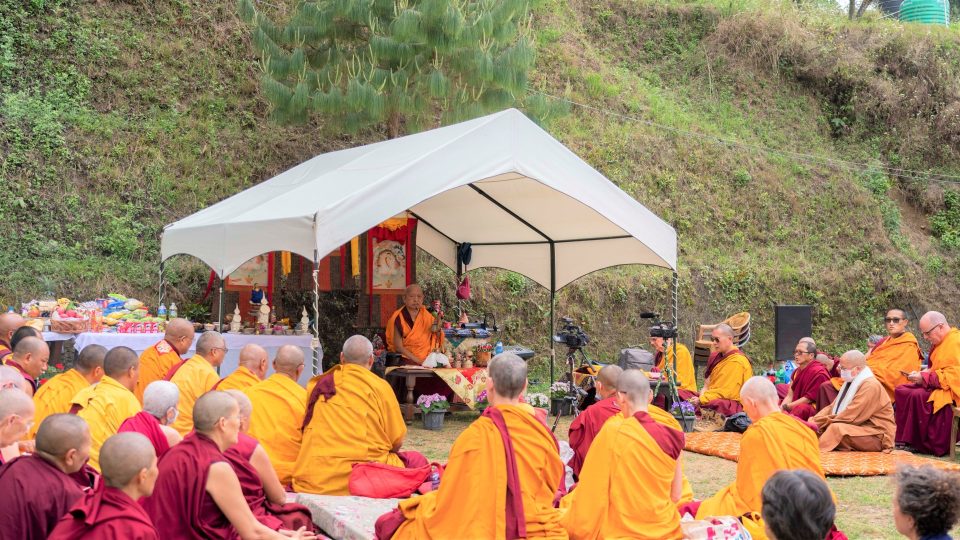
Lama Zopa Rinpoche offering a Milarepa initiation in Shavapuri Village, Nepal, April 6, 2022. Photo by Ven. Lobsang Sherab.
The great yogi Milarepa (1040-1123) is one of the most revered figures in Tibetan history and among all sects of Tibetan Buddhism. Milarepa’s guru was the famous translator, Marpa (1012-1097), himself the main disciple of Naropa (1016-1100).
Marpa taught Milarepa through a variety of seemingly futile tasks. One famous story records that Milarepa was instructed to build a large tower out of nearby boulders. Once the tower was complete, he was asked to tear it down and rebuild it in another location. Once this task was complete, he again was instructed to tear it down and rebuild. Other stories account for Marpa’s teachings on enduring and persevering through hardships. Milarepa’s devotion to his guru enabled him to progress on the path quickly.
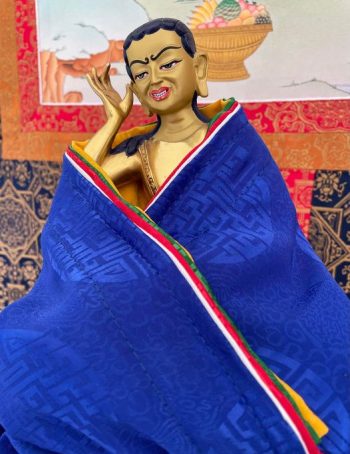
Statue of Milarepa that was brought to the initiation by Ven. Drachom. Photo by Ven. Sarah Thresher.
On April 6, Lama Zopa Rinpoche offered a Milarepa initiation and teachings to a small group of senior Kopan monks, senior Khachoe Ghakyil Ling nuns, Western sangha, and some lay students. The occasion of this initiation was for Ven. Tenzin Drachom (Fred Cheong), a long-time Singaporean student who required the initiation prior to engaging in personal retreat. The initiation was offered in Shivapuri Village, an eco-resort and conservation farm a short distance northwest of Kopan Monastery. The resort is located within the beautiful hills of Shivapuri Nagarjun National Park, which is a protected area for a diversity of wild animals.
Rinpoche arrived at Shivapuri Village at 11 a.m. for the initiation preparation while the attendees had lunch, kindly sponsored by Ven. Drachom. The teachings started around 3 p.m. with Rinpoche offering profound commentary on “Milarepa’s Hymn,” including the advice that the way to really enjoy happiness in this life is by giving up desire.
According to Ven. Thubten Khadro, who was in attendance, “Rinpoche also taught on the benefits of taking this initiation, which includes being reborn as a disciple of Milarepa and receiving direct teachings from him, and by virtue of reciting Milarepa’s mantra seven times daily, one won’t be reborn in the lower realms. Rinpoche also read ‘Calling the Guru from Afar,’ a prayer composed by Jamyang Chokyi Lodro, as a motivation for the initiation. The initiation itself was short and concluded with a blissful tsog that included vegan cakes!”
We invite you to watch the teaching that Lama Zopa Rinpoche offered prior to the Milarepa initiation. A full transcript of this teaching is available.
Lama Zopa Rinpoche is the spiritual director of the Foundation for the Preservation of Mahayana Tradition (FPMT), a Tibetan Buddhist organization dedicated to the transmission of the Mahayana Buddhist tradition and values worldwide through teaching, meditation and community service.
26
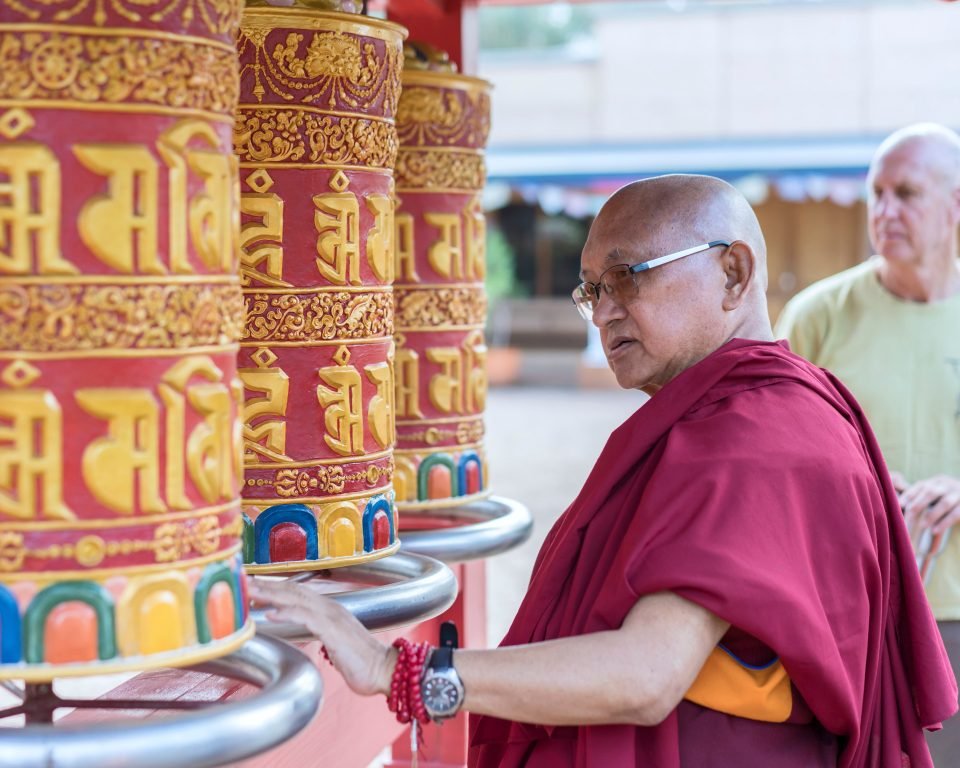
Lama Zopa Rinpoche turning prayer wheels at Atisha Centre, Bendigo, Victoria, Australia, April 2018. Photo by Ven. Lobsang Sherab.
In the new book The Power of Mantra: Vital Practices for Transformation, Lama Zopa Rinpoche guides students through understanding the power and benefit of mantras. Rinpoche explains many popular mantras, giving specific instructions for practicing them, including Shakyamuni Buddha, Chenrezig, Manjushri, Tara, Medicine Buddha, Vajrasattva, and more. In an excerpt from the chapter on Chenrezig mantra, Rinpoche discusses the importance of OM MANI PADME HUM:
Compassion is not just for those with faith in the Buddha, Dharma, and Sangha. It is not just for those who are Buddhist, for those who seek enlightenment. Everyone needs compassion. No matter what style of life we have, the compassionate life is the best life. With that, our life is totally transformed. Before it was like kaka, but now it is transformed into gold. Before there was just ego, the self-cherishing mind, but now there is compassion. Compassion brings a huge difference in our life, like the difference between the earth and the sky.
Everybody needs to recite OM MANI PADME HUM to develop compassion. We are so fortunate that with our human body we are able to communicate and to chant Chenrezig’s mantra. Ants need to recite it, whales need to, monkeys need to, but they can’t.
In many areas in Tibet and Nepal, especially along trails, there are a lot of stupas and stones carved with the Chenrezig mantra. You can see big piles of these stones, called “mani stones,” as you leave the airport at Lukla [in Solu Khumbu, Nepal]. Sometimes a whole text, such as the Heart Sutra, is carved on a stone. One of my uncles, my teacher who first taught me the alphabet when I was four, carved mani stones like this. Because of the mantra’s great benefit, you can see it everywhere, adorning prayer flags and stones, and you can hear people reciting the mantra as they pass.
Just seeing mantras on stones purifies our obscurations by leaving impressions on the mind. As with prayer flags, when the wind touches these mantras and then touches a human being or animal, it purifies the negative karmas and obscurations of that sentient being.
Just like Westerners like to recite their mantra “Oh when can I be happy,” Tibetans like to recite OM MANI PADME HUM. They recite it while they are working, cooking, or doing any of the chores they need to do. When they are not serving customers, shopkeepers recite OM MANI PADME HUM. As they walk, Tibetans will invariably have a small prayer wheel full of mani mantras, which they spin clockwise as they recite.
Prayer wheels are my hobby; they offer so many benefits. The huge prayer wheels I ask the FPMT centers to build bless all the insects on the ground and in the area, besides all the people who turn them. They are such a great blessing for the area and a quick way to liberate sentient beings from the lower realms and enlighten them. Any person who circumambulates and turns the prayer wheel receives unbelievable purification. If a prayer wheel has one hundred million manis, one turn is equivalent to saying one hundred million OM MANI PADME HUM mantras.
And that is true even of the small, hand-held prayer wheels you always see Tibetans spinning as they walk. Because of methods such as microfiche printing, they can have millions of manis in a small wheel, so one turn creates incredible merit, no matter what they are doing. Reciting OM MANI PADME HUM makes the most mundane activity highly meaningful.
The old mothers in Solu Khumbu chant OM MANI PADME HUM so much. They have almost no intellectual understanding of the Dharma, and they can’t even understand it if a lama comes to teach, because he teaches in Tibetan, not Sherpa, the only language they speak. Being illiterate, they can’t even open a Dharma book and read it, and so they have no opportunity to learn the Dharma. But by reciting OM MANI PADME HUM, somehow their hearts become so much more compassionate. They may not understand why other beings are suffering so much, but they have a strong natural feeling of compassion for others and the wish to pray for them.
This was true of my mother, who would simply recite OM MANI PADME HUM when a lama was giving teachings. Because of reciting the mani mantra, she had a hundred thousand times more compassion than I have. I can read all the texts but still my compassion is like clouds in the sky: utterly unstable, never lasting. Just before she passed away, she told me that for most of her life she recited fifty thousand manis a day, but as she became older she was no longer able to do that many. Still, I am certain the great power of her compassion came from reciting OM MANI PADME HUM. It gave her a happy, meaningful life and a happy, meaningful death.
There is a tantra called Zung of the Eleven-Face Arya Avalokiteshvara. In it Chenrezig is said to mention,
By reciting my heart mantra, sentient beings receive the bodhisattvas’ holy deeds, the heart of all the Victors, called the heart of transcendental wisdom. In short, for sentient beings tormented by various sufferings, my heart mantra will abide and become a guide for them. Also, this heart mantra hooks the harm-givers, such as the flesh-eaters and other violent spirits, and causes them to generate loving-kindness and compassion. It then brings them to enlightenment.
Furthermore, he says,
Any sentient being who holds my name will abide in nonreturning. They will be completely liberated from all sicknesses and from all the defilements, all the vices collected with the body, speech, and mind.
It is not enough just to be able to say the words of the mantra; we should first cultivate as positive a motivation as we can—and the bodhichitta motivation is the best—and then recite it. Whoever recites the mantra with a bodhichitta motivation is somebody who really knows how to recite it. It is said in the teachings that the greater devotion we have for Chenrezig, the more power and benefit the mantra has.
From The Power of Mantra: Vital Practices for Transformation by Lama Zopa Rinpoche; compiled and edited by Gordon McDougall; published by Wisdom Publications (WisdomExperience.org), where you can order the paperback or digital versions of the book. You can also find the ebook and PDF version in the Foundation Store (shop.fpmt.org).
Visit the Foundation Store to also find a wide variety of Chenrezig practice materials. For more on mantras, see our Mantras page on FPMT.org.
Lama Zopa Rinpoche is the spiritual director of the Foundation for the Preservation of Mahayana Tradition (FPMT), a Tibetan Buddhist organization dedicated to the transmission of the Mahayana Buddhist tradition and values worldwide through teaching, meditation and community service.
- Tagged: mani, mani mantra, om mani padme hum
22
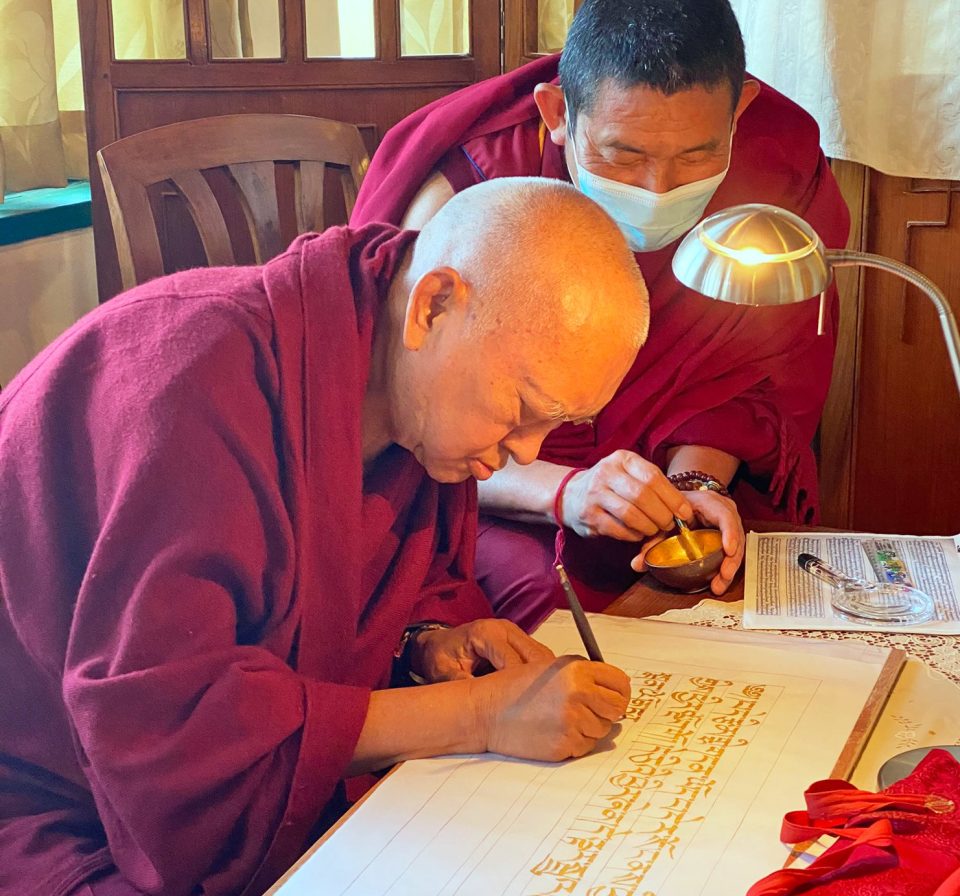
Lama Zopa Rinpoche writing out the Prajnaparamita Sutra, Kopan Monastery, Nepal, January 2022. Photo by Ven. Roger Kunsang.
During these difficult times, FPMT Spiritual Director Lama Zopa Rinpoche continues to offer profound advice and inspiration to the FPMT organization. Rinpoche’s message in the FPMT Annual Review 2021: Sharing and Preserving the Dharma in a Changing World focuses on having the correct motivation. He explains how our purpose in life is to benefit every single living being, to cherish and offer compassion to not only those who benefit us, but those who are strangers, and even those who harm us. Here is an excerpt from Rinpoche’s advice:
My Most Dear, Most Kind, Most Precious Wish-fulfilling Ones,
It is so important to continually develop compassion for sentient beings. That is the source of happiness for every single hell being, hungry ghost, animal, human being, sura being, asura being, and intermediate state being.
It is said in the sutra Perfectly Contained Holy Dharma of Arya Compassionate One (འཕག་པ་སྤྱན་རས་གཟིགས་གྱི་ཆོས་ཡང་དག་པར་སྡུད་པ་ལས):
If you wish to achieve enlightenment quickly, do not follow many Dharmas. Follow one Dharma. What is that? That is great compassion. Whoever has great compassion has all the Dharmas of the buddhas in the palm of their hands. They are achieved without effort. In short, great compassion is the root of all Dharma.
It is said in the Middle Gomrim:
Even if you are standing, even if you are going, you should meditate on great compassion toward sentient beings.
This just mentions two activities as an example, but it means all the actions—sleeping, eating, working, reading, writing, everything—should be done with compassion. This is the advice. Especially during that time, you yourself will be at peace and have happiness and other sentient beings won’t receive harm from you.
And it is said in the first verse of the Eight Verses of Thought Transformation, as you know well:
Determined to obtain the greatest possible benefit
From all sentient beings,
Who are more precious than a wish-fulfilling jewel,
I hold them most dear at all times.
This means by cherishing not only the people who help you but even strangers, who neither help or harm you, and then especially cherishing those who harm you—of course, bodhicitta is the best of great compassion—what you get from that person is enlightenment, the total cessation of every mistake, every defilement, and every subtle negative karma, and the completion of all realizations, sang gyä. That is what you get from that person who you call enemy, who abuses you, who harms you with their body, who harms you with their speech, or who harms you with their mind.
As I have mentioned many times in advice given to others, from every sentient being you receive all the past, present, and future happiness, including enlightenment, even the happiness you have in a dream. I can repeat it again here. From this obscured suffering sentient being, even the one who you call enemy, great compassion arises, wishing not only to free sentient beings from suffering but to take that responsibility upon yourself. Then, from there, bodhicitta arises. From bodhicitta, a bodhisattva arises. From a bodhisattva, a buddha arises. A buddha has two actions, one is their own heart’s action and one is within us sentient beings—that is, when we create good karma. So, all our good karma is the buddhas’ actions. Now you can see that from that buddha’s action, good karma, all the past, present, and future happiness, including enlightenment, happened.
Buddha, Dharma, and Sangha, who we take refuge in at the beginning of a practice, cause us to protect karma, liberate us from the lower realms, free us from samsara, and cause us to practice the three higher trainings. And not only that, they cause us to achieve enlightenment by freeing us from being caught in the lower nirvana for many eons. Then they cause us to generate bodhicitta, practice the six paramitas, and so forth. Even these extremely precious ones, Buddha, Dharma, and Sangha, come from every sentient being, from your friends, strangers, and even your enemies. Therefore, the numberless Buddha, Dharma, and Sangha, from whom you get all these benefits, come from this mosquito, from this tiniest insect near you on the table, on humid wood, or anywhere. So therefore, these sentient beings are the most precious, most kind, most dear, most wish-fulfilling. Even from this, it makes you think, “How dare I cause them unhappiness?” There is no way to do that. It is totally opposite: they are to be cherished the most. You can see they are the most important, precious one in your life.
So, as it says in that quotation from Middle Gomrim, all day and night your motivation should be compassion. Whatever action you are doing, you are doing it for sentient beings, dedicating it for sentient beings. …
Read Rinpoche’s complete advice in this years online annual review.
Visit FPMT.org, where you can watch more video teachings from Lama Zopa Rinpoche as part of his Teachings on Thought Transformation and find links to related videos, transcripts, MP3s, and additional practice advice.
Lama Zopa Rinpoche is the spiritual director of the Foundation for the Preservation of Mahayana Tradition (FPMT), a Tibetan Buddhist organization dedicated to the transmission of the Mahayana Buddhist tradition and values worldwide through teaching, meditation and community service.
18

Rinpoche making prayers in offering room overlooking Boudha Stupa, Nepal, April 2022. Photo by Ven. Roger Kunsang.
In January, Lama Zopa Rinpoche gave advice on how to collect “the most unbelievable merit” when making offerings, recently published as Offerings to the Boudha Stupa. Rinpoche offered this advice in relation to a rented room that overlooks Boudha Stupa, in Nepal, and that has been filled with offerings. Rinpoche’s advice was printed, framed, and hung in this offering room to serve as a reminder of how one should make offerings.
This advice from Rinpoche, however, can be followed whenever offerings are made to holy objects as it contains the essence of the meditation for making offerings, which Rinpoche elaborated in Extensive Offering Practice.
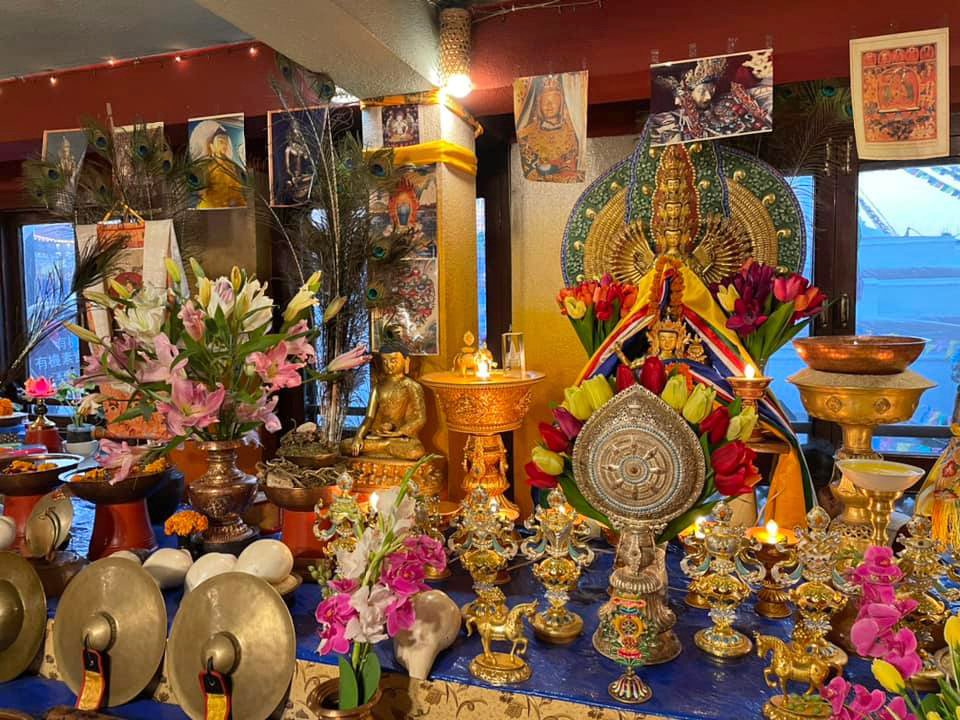
Offering room overlooking Boudha Stupa, Nepal, March 2022. Photo by Ven. Sarah Thresher.
“There’s no question how much merit you will collect with each offering you make to the Stupa while thinking that, in essence, it is your root guru,” Rinpoche says in Offerings to the Boudha Stupa.
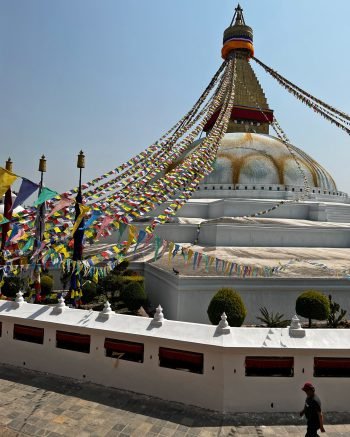
Boudha Stupa, Nepal, March 2022. Photo by Ven. Roger Kunsang.
“You collect the most unbelievable merit and it becomes purification as well. Please think this with any offering you make to the Stupa, and then offer it on behalf of all sentient beings: the offerings are theirs and you are offering them on their behalf. So then every sentient being gets merit—every hell being gets merit, every hungry ghost gets merit, every animal gets merit. For example, every ant gets merit, every mosquito gets merit, and every chick gets merit. No matter how tiny it is and no matter how big it is, every animal gets merit. Also, every human being, every asura, and every sura gets merit. In this way, the offering helps them to become free from their suffering of pain and to receive peace and pleasure.”
Rinpoche frequently goes to Boudha Stupa to circumambulate and to make offerings and prayers. In September 2021, Rinpoche recorded a Thought Transformation Teaching video called, “Making Offerings to Boudha Stupa.” At the beginning of this video, Rinpoche talks about doing a tsog offering practice at Boudha Stupa and the benefits of making offerings to stupas. He explains how offering tsog to stupas makes you achieve all the realizations; offering medicine to stupas stops diseases; and offering grains to stupas stops famine in the world. Rinpoche also discusses how important it is to consecrate stupas, including the benefit of eliminating war. Rinpoche then led an offering practice to Boudha Stupa accompanied by many senior Sangha members. (You can follow along with the offering practice by watching the video.)
Watch Rinpoche making prayers in the offering room next to Boudha Stupa:
Find Offerings to the Boudha Stupa as a PDF in the Foundation Store:
https://shop.fpmt.org/Offerings-to-the-Boudha-Stupa-PDF-_p_3682.html
Through comprehensive study programs, practice materials, and training seminars, FPMT Education nourishes the development of compassion, wisdom, kindness, and true happiness in individuals of all ages.
14

Lama Zopa Rinpoche during the long life puja offered to him, Kopan Monastery, Nepal, March 2022. Photo by Ven. Lobsang Sherab.
Since our last update, Lama Zopa Rinpoche has remained in Nepal, engaging in a variety of auspicious activities, including doing a personal retreat. Rinpoche also was offered a long life puja, met with important people and lamas, offered prayers and pujas during the Fifteen Days of Miracles, created merit in relation to holy objects, attended the inauguration of a new dialysis clinic, and offered two new teachings. We invite you to read more about these activities below and to join us in rejoicing in the compassionate service Rinpoche offers every day, inspiring us all to live a full and beneficial life.
Long Life Puja
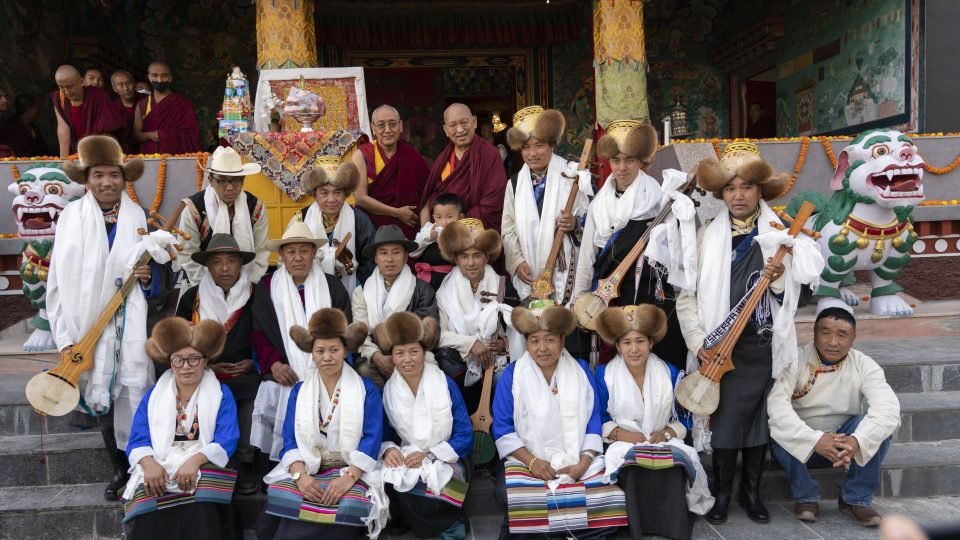
Lama Zopa Rinpoche with the Sherpa dancers following the long life puja offered to Rinpoche at Kopan Monastery, Nepal, March 11, 2022. Photo by Ven. Lobsang Sherab.
A long life puja was offered on behalf of the entire FPMT organization to Lama Zopa Rinpoche at Kopan Monastery, Nepal, on March 11. The puja was a joyful occasion that included lama and Sherpa dances in the courtyard and a picnic in the stupa garden. There were several days of preparatory practices done by Kopan monks and nuns leading up to the long life puja. On the day of the puja, Kopan Abbot Khen Rinpoche Geshe Chonyi, Yangsi Rinpoche, Losang Namgyal Rinpoche, Rigsel Rinpoche, Kopan monks and nuns, and many others were in attendance.
Teachings and Advice
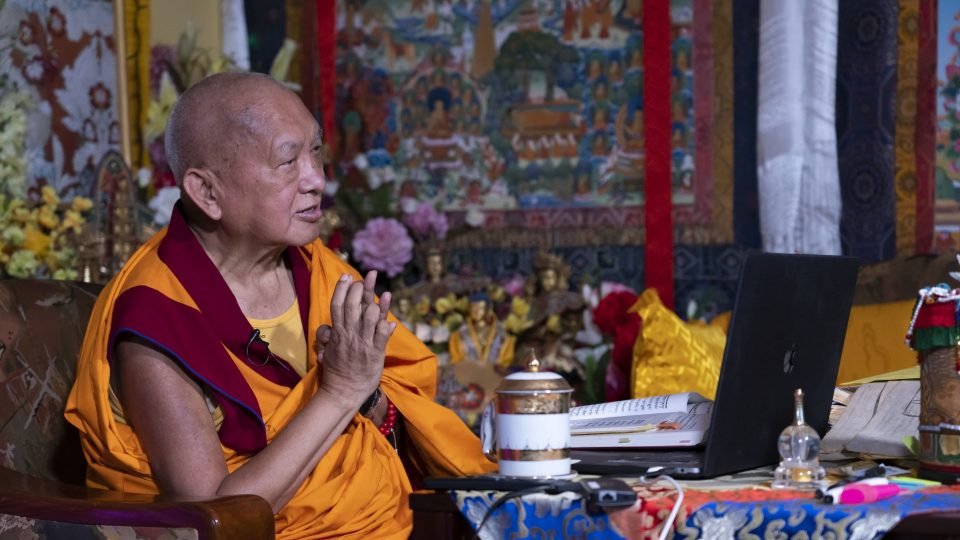
From Kopan Monastery, Rinpoche offering a talk to Sangha at the beginning of a three-month Vinaya course helded at Istituto Lama Tzong Khapa, Italy, March 2022. Photo by Ven. Lobsang Sherab.
On February 25, Rinpoche offered timely advice regarding practices to reduce the war in Ukraine and to help stop violence and suffering. Rinpoche also arranged a number of powerful pujas, such as controlling fire pujas, wrathful fire pujas, and Drugchuma (Sixty-Four Offerings to Kalarupa).
Rinpoche also gave two teachings recorded on video recently, which we’ve shared in blog posts complete with summaries:
- The Western Sangha Are the Real Heroes, a teaching Rinpoche offered at the beginning of a three-month course on the Vinaya being held at Istituto Lama Tzong Khapa.
- Why Buddhism Is So Important, a teaching Rinpoche offered to the Vajrasattva retreatants at Kopan Monastery.
Meeting with Important Individuals
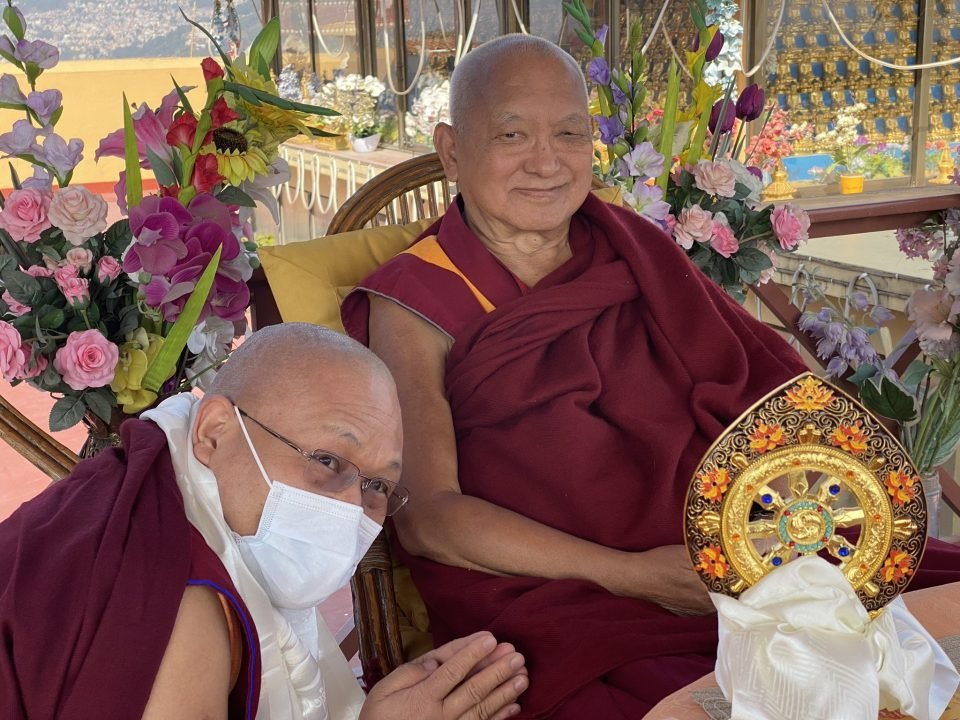
Lama Zopa Rinpoche meeting with Geshe Jampa Tsundue, resident teacher of Lobsang Dragpa Centre in Malaysia, at Kopan Monastery, January 2022. Photo by Ven. Roger Kunsang.
In early January, Rinpoche invited Khadro-la (Rangjung Neljorma Khadro Namsel Drönme) for lunch at a nice resort outside of Kathmandu with breathtaking panoramic views of snow-capped mountains. While there, Rinpoche and Khadro-la also offered prayers and pujas. Later in January at Kopan Monastery, Rinpoche met with Geshe Jampa Tsundue, resident teacher of Lobsang Dragpa Centre, Malaysia.
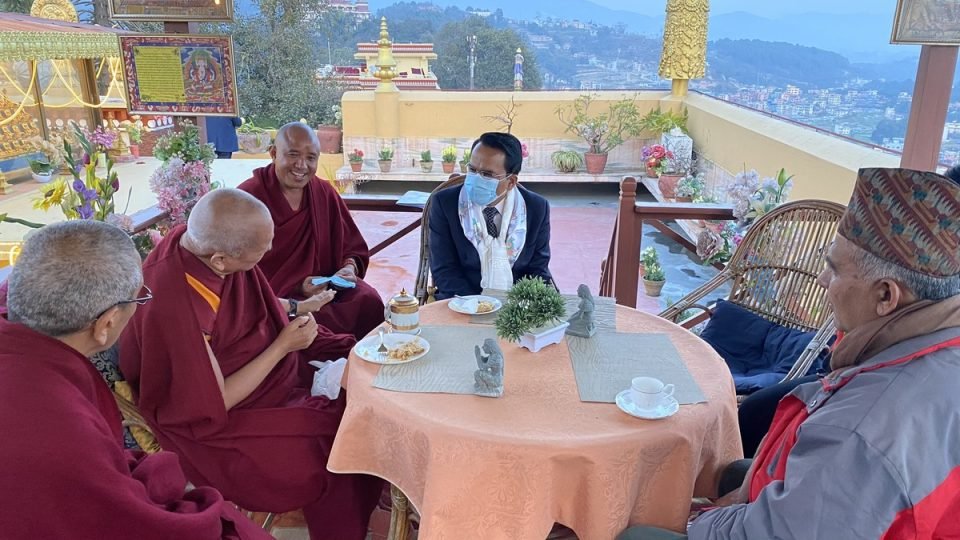
Khen Rinpoche Geshe Chonyi, Lama Zopa Rinpoche, Phuba Chhbe Sherpa (Bikkhu Thubten Jikdol), Chairman of the National Planning Commission of the Ministry of Education, and Dr. Biswo Nath Poudel, Vice Chairman, discussing education topics during a visit to Kopan Monastery, Nepal, February 23, 2022. Photo by Ven. Roger Kunsang.
Rinpoche met the Chairman and Vice Chairman of the National Planning Commission of the Ministry of Education in February. They spoke about many subjects, such as the Mount Everest School at Kopan Monastery, education within monasteries, Dharma education, as well as secular education focusing on compassion and kindness.
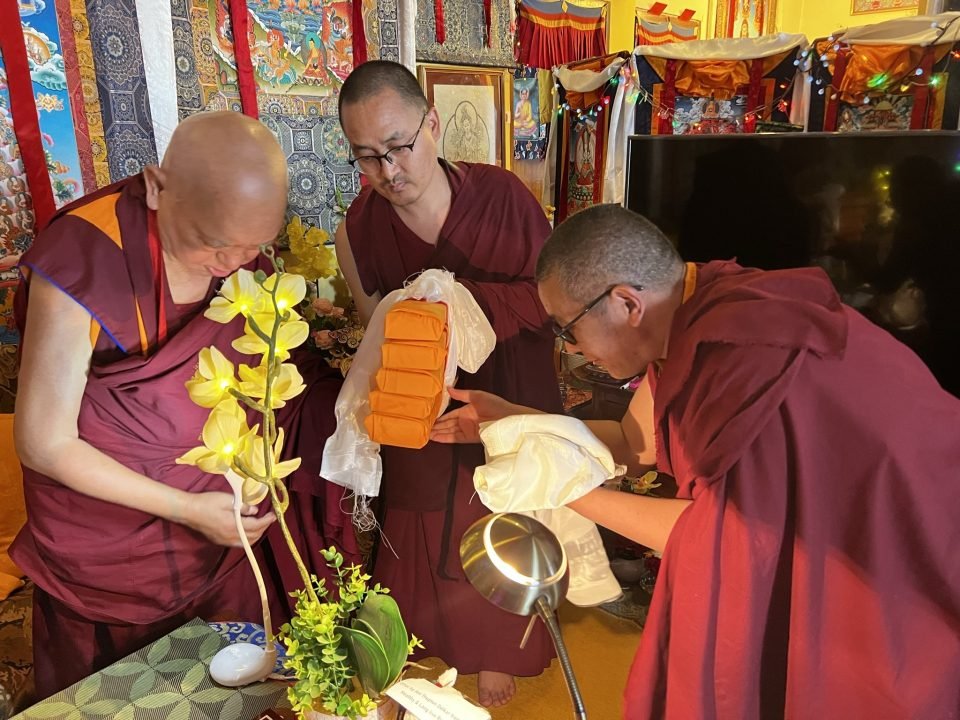
Lama Zopa Rinpoche with Lama Ngawang Chokyab at Kopan Monastery, Nepal, March 13, 2022. Photo by Ven. Roger Kunsang.
In March, Rinpoche met with Lama Ngawang Chokyab, a Nyingma lama and disciple of Trulshik Rinpoche, at Kopan Monastery. Rinpoche also met with Serkong Dorje Chang at his monastery in Swayambhunath.
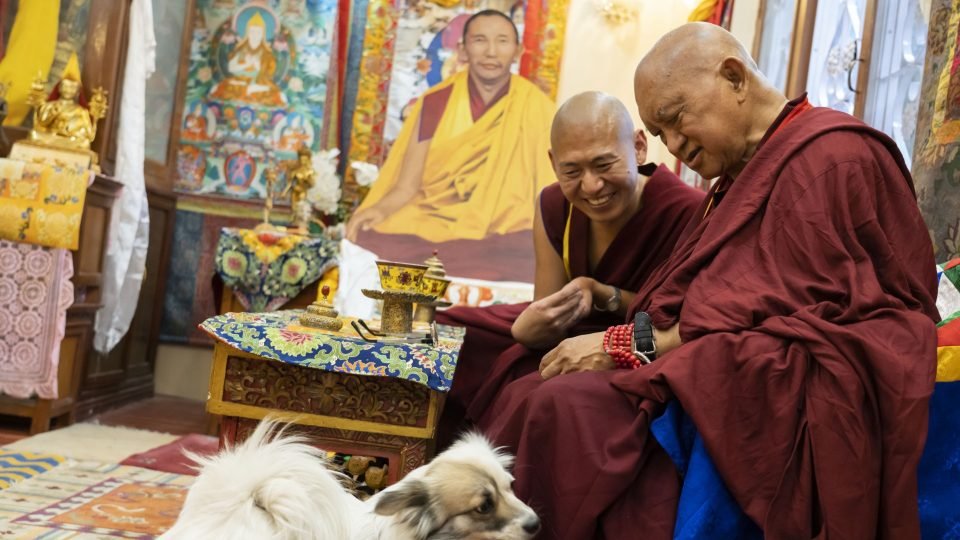
Lama Zopa Rinpoche meeting with Serkong Dorje Chang at his monastery in Swayumbhunath, Nepal, March 13, 2022. Photo by Ven. Lobsang Sherab.
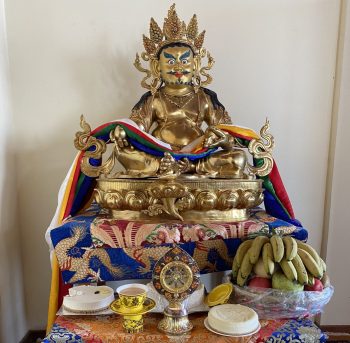
New 3.5-foot (1-meter) tall Dzambhala statue being welcomed to Kopan Monastery.
Holy Objects
Rinpoche greeted a new 3.5-foot (1-meter) tall Dzambhala statue, which arrived at Kopan in January. Rinpoche personally welcomed the statue with prostrations, a five-colored khata offering, a mandala offering, and tsog. Rinpoche wrote a special letter to Dzambhala with prayers and requests for the organization and all beings, and offered this letter of requests to Dzambhala.
Rinpoche made trips to Swayambhunath and Boudha stupas, offering teachings, prayers, and khatas with others.
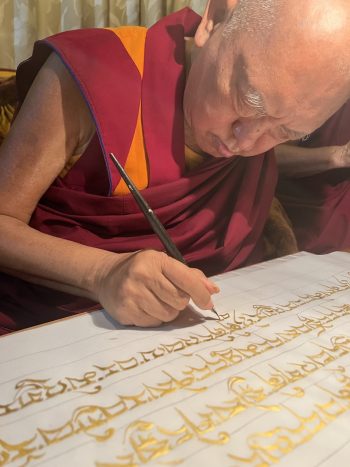
Lama Zopa Rinpoche writing out the Prajnaparamita Sutra, Kopan Monastery, Nepal, March 2022. Photo by Ven. Roger Kunsang.
Rinpoche continued to write out the 8,000 verse Prajnaparamita Sutra in pure gold. Under Rinpoche’s guidance several students have been writing out the Prajnaparamita on archival quality rainbow paper, including Ven. Tsering, who is now based at Kopan Monastery and is writing out volumes from the 12,000 verse Prajnaparamita, as well as Jane Seidlitz in United States and Ven. Nina at Khachoe Ghakyil Ling Nunnery in Nepal.
Offering Prayers and Pujas
Rinpoche offered sur practice at night at Kopan Monastery in front of the 1,000 Buddha altar on the roof of Kopan’s main gompa. Rinpoche has explained that by offering sur practice, one will have success and be born in a pure land, and whatever work one is doing will be successful and not have obstacles.
Most Secret Hayagriva tsog kong was offered at Kopan for Rinpoche’s long life and for the success of the entire organization on March 2. Rinpoche, Khen Rinpoche Geshe Chonyi, and Kopan monks offered Palden Lhamo puja to start the new year auspiciously on March 3. Lama Chopa was also offered at Kopan Monastery on Losar. On the third day of Losar, Rinpoche led incense puja with Khen Rinpoche Geshe Chonyi and senior Kopan monks on Kopan Hill, where they made strong prayers for all beings and to remove obstacles and bring success.
On April 2, Rinpoche attended a long life puja for Khadro-la.
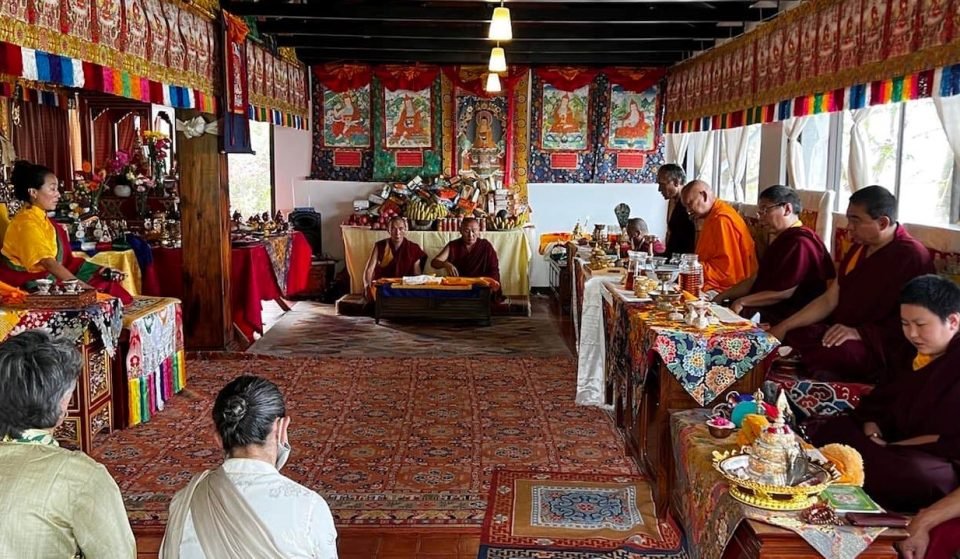
Long life puja offered to Khadro-la (Rangjung Neljorma Khadro Namsel Drönme), Kathmandu, Nepal, April 2, 2022. Photo by Ven. Roger Kunsang.
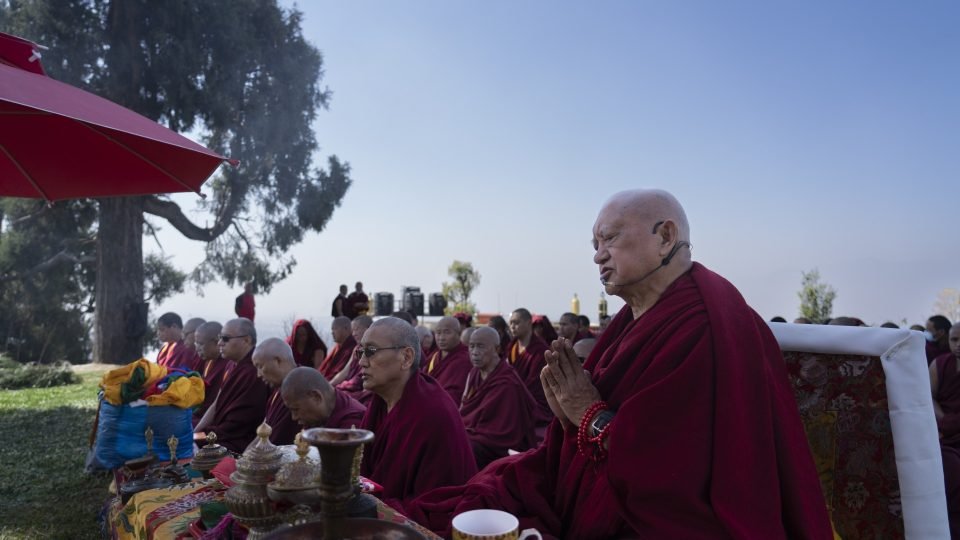
Lama Zopa Rinpoche leading an incense puja on Kopan Hill with Khen Rinpoche Geshe Chonyi and monks of Kopan Monastery, Losar, March 3, 2022. Photo by Ven. Lobsang Sherab.
Maya Daya Clinic
Maya Daya Clinic, established in 1992 at the foot of Kopan Hill, is one way Kopan Monastery has been actively serving the local community. At the time it was created, there was very little medical care in the area, with doctors and pharmacies only accessible in Boudhanath, a forty-five minute walk away. The aim of the clinic was to provide basic healthcare for the local population, with a doctor and nurse available three days a week and regular access to medical supplies at the clinic’s pharmacy. In the years since then, the clinic has benefited thousands of local patients as well as the monks and nuns of Kopan and of other monasteries.
With the need for basic medical care in the local area now well covered by other clinics and pharmacies, Maya Daya Clinic, in cooperation with Karuna Hospital, is taking the next step in its development. As part of an expansion of Karuna Hospital, the clinic will be serving the local community by providing dialysis to those with chronic kidney disease in a comfortable and modern environment. This is an incredible achievement for Kopan Monastery to be able to offer support to the local community in this way. Through the leadership of Ven. Sangye Tenzin, government support has also been obtained for this clinic, which is desperately needed by the local population who will be able to receive dialysis for free.
Lama Zopa Rinpoche attended the inauguration of this clinic on March 5 with Khen Rinpoche Geshe Chonyi. Rinpoche offered a statue of Buddha for the front of Karuna Hospital and also designed the beautiful image of Shakyamuni Buddha with mantras that you can see below in the photo. Please read more about this amazing project.
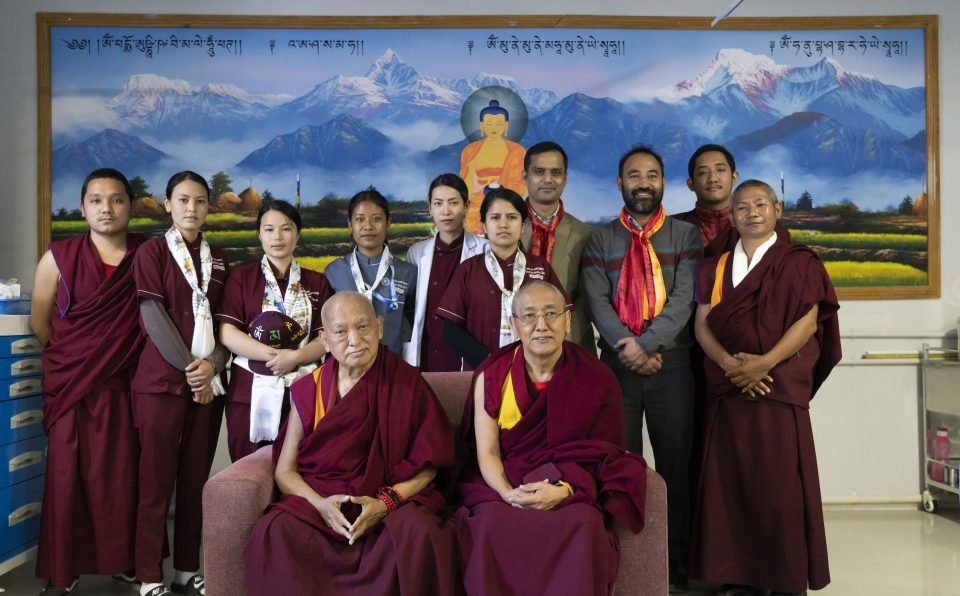
Lama Zopa Rinpoche and Khen Rinpoche Geshe Chonyi attending the inauguration of the Maya Daya Clinic at Karuna Hospital on March 5, 2022. Rinpoche designed the image of Shakyamuni Buddha with mantras in the background. Photo by Ven. Lobsang Sherab.
We invite you to see more photos of Rinpoche in our January–March 2022 photo album:
https://fpmt.org/teachers/zopa/gallery/nepal-january-march-2022/
Lama Zopa Rinpoche is the spiritual director of the Foundation for the Preservation of Mahayana Tradition (FPMT), a Tibetan Buddhist organization dedicated to the transmission of the Mahayana Buddhist tradition and values worldwide through teaching, meditation and community service.
- Tagged: lama zopa rinpoche, lama zopa rinpoche long life puja, long life puja, long life puja for lama zopa rinpoche
13

Lama Zopa Rinpoche offering a teaching to students who attended the Vajrasattva retreat at Kopan Monastery, March 2022. Photo by Ven. Lobsang Sherab.
Lama Zopa Rinpoche offered this highly charged teaching on March 30, 2022, to students attending the three-month Vajrasattva retreat at Kopan Monastery in Nepal. Here’s a summary of the teaching with the video below:
Our minds are wrapped up in hallucination, Rinpoche warns. We must use the wisdom of Buddha’s teachings to see the truth, to recognize all the hallucinations we are wrapped up in. The world has so much suffering due to ignorance.
Because we took rebirth, there are problems. To be free from suffering in samsara, we have to be free from delusions and karma, but we are creating the root of samsara twenty-four hours a day due to ignorance! The nature of samsaric pleasure is suffering, however, our ignorance projects real pleasure from its own side! Real pleasure is not there at all, and all the things that appear as real are a total hallucination.
It is very important to know how we hallucinate. Normally we think others hallucinate, but we have been hallucinating from beginningless rebirths up to now and that makes us suffer. Therefore, learning Buddhism, the words and meanings, and practicing it is most important, more important than food and money, Rinpoche explains. If you know Dharma, you come to know that is the most important thing. Money and jobs come from Dharma. In the past you made charity to others, so in this life you have the means of living, food, and shelter. People think money and jobs are the most important things in life. Even those who know Dharma think it is second or third. That is totally wrong. Dharma is first. Everything, including money and jobs, come from cherishing others, from practicing Dharma.
At the end of the teaching, Rinpoche offers the oral transmission of the Vajrasattva mantra (1:30:05) and the oral transmission of Dorje Khadro fire puja practice (1:42:50).
UPDATE (May 4, 2022): Rinpoche has confirmed that one may receive these oral transmissions by watching the video.
We invite you to go deeper into the topics presented here, plus many others, by watching Rinpoche’s video or reading the full transcript of Rinpoche’s teaching.
Watch Lama Zopa Rinpoche’s teaching “Why Buddhism Is So Important”
Lama Zopa Rinpoche gave four teachings to students attending the 2022 Vajrasattva retreat: this introductory teaching on March 30 and three subsequent teachings on April 26–28. You can find them on our page “Teachings for 2022 Vajrasattva Retreatants at Kopan Monastery.”
You can find links to resources to support your Vajrasattva practice and Dorje Khadro practice in the Foundation Store.
This summary of Lama Zopa Rinpoche’s teaching is by Carina Rumrill, based on the live transcript by Ven. Joan Nicell and checked by Laura Haughey, with editorial input and additions by Laura Miller. This summary is meant to highlight key topics presented by Rinpoche in the recorded video and is not intended to serve as a full representation of Rinpoche’s teaching, which is best received through watching the video and/or reading the full transcript.
Lama Zopa Rinpoche is the spiritual director of the Foundation for the Preservation of Mahayana Tradition (FPMT), a Tibetan Buddhist organization dedicated to the transmission of the Mahayana Buddhist tradition and values worldwide through teaching, meditation and community service.
8
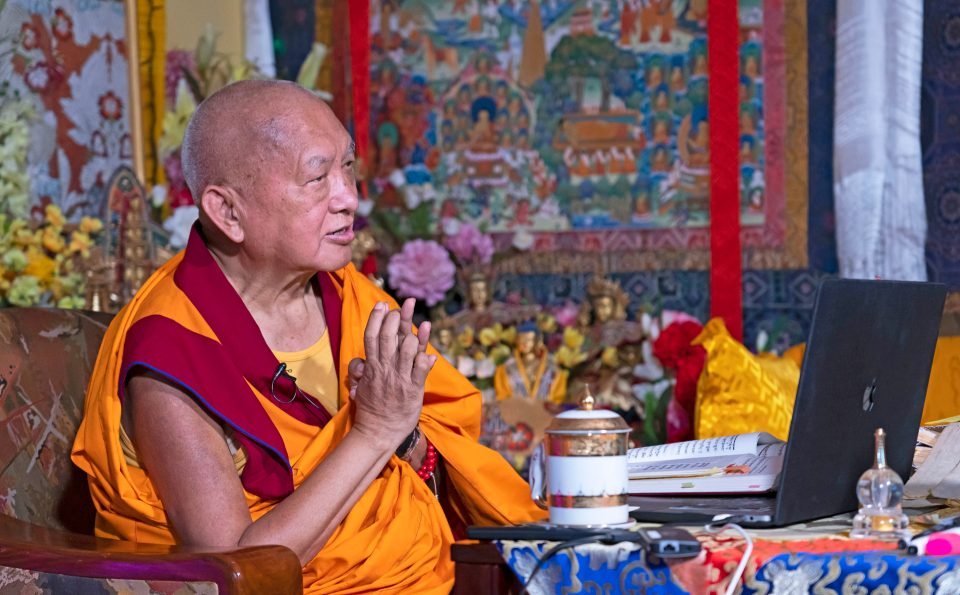
From Kopan Monastery, Rinpoche offering a talk to Sangha at the beginning of a three-month Vinaya course held at Istituto Lama Tzong Khapa, Italy, March 7, 2022. Photo by Ven. Lobsang Sherab.
Lama Zopa Rinpoche offered this video teaching on March 7, 2022, from Kopan Monastery in Nepal to ordained Sangha at the beginning of a three-month course on the Vinaya being held at Istituto Lama Tzong Khapa in Italy. This teaching contains advice that is useful to all of us, lay and ordained alike. Here’s a summary of the teaching with the video below:
In order to live a meaningful life, we need a precise plan, Rinpoche says. This means establishing a daily intention to improve our lives. For example, while establishing a lamrim motivation for the day, one can make the determination not to be controlled by anger, no matter what happens in life that day. This way, during the day when the conditions arise and you are about to get angry, you can remember what you promised in the morning.
Because our minds have been habituated with anger since beginningless rebirths, anger comes like a tsunami. And it is very dangerous. It destroys our liberation by destroying our merit. It also harms others by causing them to get angry, thus destroying their merit and liberation. Since we have a responsibility for every sentient being, we must keep our minds in peace by practicing loving kindness, compassion, patience, contentment, and especially bodhicitta. Furthermore, all of our happiness, including buddhahood, comes from every sentient being.
Rinpoche then addresses the Sangha directly, explaining that Western Sangha are “the real heroes” because becoming ordained in Western culture is very difficult, and it is also very difficult to keep vows in the West. In our culture we praise people who command armies or participate in killing as heroes, but so much negative karma is accumulated, including suffering in the lower realms for eons. The Sangha, however, make war on the delusions, which are the cause of so much suffering to one’s self and others, and they defeat them. They are the real heroes.
Protecting one’s ordination is preserving the Buddha’s teachings. Buddha said in the Sutra of Individual Liberation that the practice of morality is the Buddha. “Kyabje Phabongkha Dechen Nyingpo said your morality is ku tshab, is Buddha, is a substitute of Buddha, a regent of Buddha. Thinking in that way, you must cherish and protect your morality,” Rinpoche explained.
Morality in a country depends on whether or not there are people there practicing Buddha’s teachings. And the presence of teachings depends on whether or not Sangha are there.
“You abandon your happiness by breaking your morality,” Rinpoche warns. There are so many benefits to living in vows, even for lay people living in vows for one day. Rinpoche then outlines and offers commentary on the four doors for receiving downfalls from breaking vows and offers advice on how to prevent downfalls.
In essence, Rinpoche advises, in each second during this one time we have this human rebirth, if we live with renunciation, whatever we are doing becomes a cause of liberation, not a cause of samsara. Each second of remembering emptiness becomes an antidote to samsara; it destroys the root of samsara—ignorance. And in each second, if you remember bodhicitta, everything you do becomes a cause of enlightenment. This is how you can make your life most beautiful, most meaningful, to yourself and to all sentient beings.
We invite you to go deeper into the topics presented here, plus many others, by watching Rinpoche’s video and reading the full transcript of this teaching.
Watch Lama Zopa Rinpoche’s teaching “The Western Sangha Are the Real Heroes”
This summary of Lama Zopa Rinpoche’s teaching is by Carina Rumrill, based on the live transcript by Ven. Joan Nicell and checked by Laura Haughey, with editorial input and additions by Laura Miller. This summary is meant to highlight key topics presented by Rinpoche in the recorded video and is not intended to serve as a full representation of Rinpoche’s teaching, which is best received through watching the video and/or reading the full transcript.
Visit FPMT.org, where you can watch more video teachings from Lama Zopa Rinpoche as part of his Teachings on Thought Transformation and find links to related videos, transcripts, MP3s, and additional practice advice, and where you can also discover more advice from Rinpoche specifically for Sangha.
Lama Zopa Rinpoche is the spiritual director of the Foundation for the Preservation of Mahayana Tradition (FPMT), a Tibetan Buddhist organization dedicated to the transmission of the Mahayana Buddhist tradition and values worldwide through teaching, meditation and community service.
- Tagged: advice from lama zopa rinpoche, ethics, lama zopa rinpoche advice for sangha, sangha, video, vows
6
The Definition of Having Generated Bodhicitta
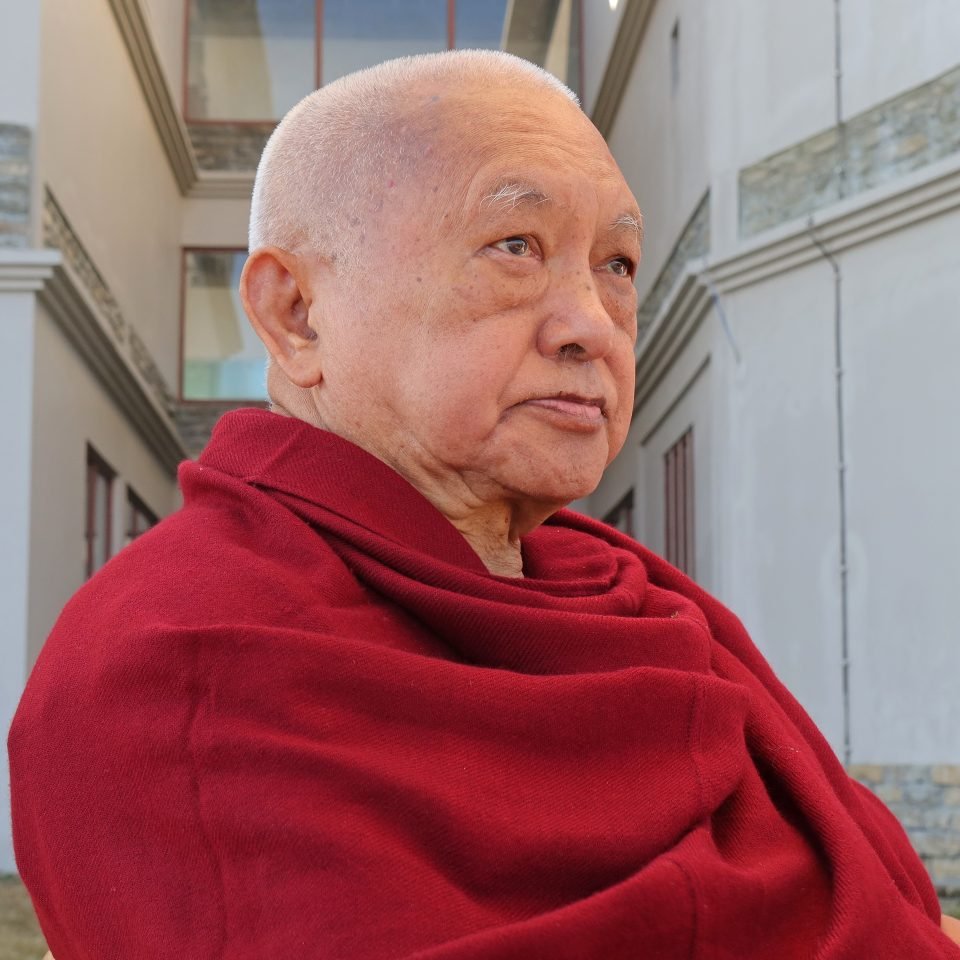
Lama Zopa Rinpoche, Pokhara, Nepal, December 2021. Photo by Ven. Roger Kunsang.
The following video is an Essential Extract from Lama Zopa Rinpoche. Essential Extracts are short videos extracted from a longer teachings that focuses on a specific topic. We have more than two hundred Essential Extract videos available on our website. We also routinely share these Essential Extract videos in blog posts, which include transcripts and links to additional materials. Here is a short Essential Extract on generating the mind of bodhicitta.
In the video, Rinpoche describes how you need to develop unbelievably strong compassion before realizing bodhicitta. The example given is of a mother whose greatly cherishes child falls into a fire. She can’t stand that her child is suffering in the fire for even one second. However many minutes or seconds it takes to save the child, it’s too long for her mind. Rinpoche explains that our minds should be like the mother’s mind: we can’t stand that the countless mother sentient beings are experiencing unbearable suffering for one more second. And on this basis, we develop the effortless wish to achieve omniscience.
In the video Rinpoche is referring to Phabongkha Rinpoche’s commentary on Lama Tsongkhapa’s Three Principal Aspects of the Path. In particular, the commentary is on this stanza from the section “The Definition of Having Generated the Mind of Enlightenment”:
In short, if like the mother whose cherished son has fallen into a pit of fire
And who experiences even one second of his suffering as an unbearable eternity,
Your reflection on the suffering of all mother sentient beings
Has made it impossible for you to bear their suffering for even one second
And the wish seeking enlightenment for their sake arises without effort,
Then you have realized the supreme precious mind of enlightenment.
Watch the video “The Definition of Having Generated Bodhicitta”:
Read the transcript for this Essential Extract:
https://fpmt.app.box.com/s/af91ega3quffors6clch5g2mkak0m4j4
The above video is extracted from a Thought Transformation Teaching video recorded on October 24, 2020, at Kopan Monastery in Nepal. You can find more blogs with short video clips from Rinpoche’s teaching as well as the complete collection of these “Essential Extracts” videos on FPMT.org.
Watch videos from the series Lama Zopa Rinpoche’s Teachings on Thought Transformation and find links to transcripts, MP3s, additional practice advice, and more. Read an in-depth summary of Rinpoche’s thought transformation teachings given in 2020 in the Mandala 2021 article “The Time to Practice Is Now.”
Lama Zopa Rinpoche is the spiritual director of the Foundation for the Preservation of Mahayana Tradition (FPMT), a Tibetan Buddhist organization dedicated to the transmission of the Mahayana Buddhist tradition and values worldwide through teaching, meditation and community service.
- Home
- News/Media
- Study & Practice
- About FPMT Education Services
- Latest News
- Programs
- New to Buddhism?
- Buddhist Mind Science: Activating Your Potential
- Heart Advice for Death and Dying
- Discovering Buddhism
- Living in the Path
- Exploring Buddhism
- FPMT Basic Program
- FPMT Masters Program
- FPMT In-Depth Meditation Training
- Maitripa College
- Lotsawa Rinchen Zangpo Translator Program
- Universal Education for Compassion & Wisdom
- Online Learning Center
- Prayers & Practice Materials
- Overview of Prayers & Practices
- Full Catalogue of Prayers & Practice Materials
- Explore Popular Topics
- Benefiting Animals
- Chenrezig Resources
- Death & Dying Resources
- Lama Chopa (Guru Puja)
- Lama Zopa Rinpoche: Compendium of Precious Instructions
- Lama Zopa Rinpoche: Life Practice Advice
- Lama Zopa Rinpoche Practice Series
- Lamrim Resources
- Mantras
- Prayer Book Updates
- Purification Practices
- Sutras
- Thought Transformation (Lojong)
- Audio Materials
- Dharma Dates – Tibetan Calendar
- Translation Services
- Publishing Services
- Teachings and Advice
- Find Teachings and Advice
- Lama Zopa Rinpoche Advice Page
- Lama Zopa Rinpoche: Compendium of Precious Instructions
- Lama Zopa Rinpoche Video Teachings
- ༧སྐྱབས་རྗེ་བཟོད་པ་རིན་པོ་ཆེ་མཆོག་ནས་སྩལ་བའི་བཀའ་སློབ་བརྙན་འཕྲིན།
- Podcasts
- Lama Yeshe Wisdom Archive
- Buddhism FAQ
- Dharma for Young People
- Resources on Holy Objects
- Ways to Offer Support
- Centers
- Affiliates Area
- Teachers
- Projects
- Charitable Projects
- Make a Donation
- Applying for Grants
- News about Projects
- Other Projects within FPMT
- Support International Office
- Projects Photo Galleries
- Give Where Most Needed
- FPMT
- Shop
Translate*
*powered by Google TranslateTranslation of pages on fpmt.org is performed by Google Translate, a third party service which FPMT has no control over. The service provides automated computer translations that are only an approximation of the websites' original content. The translations should not be considered exact and only used as a rough guide.It’s the foggy mind, the mind that’s attracted to an object and paints a distorted projection onto it, that makes you suffer. That’s all. It’s really quite simple.







